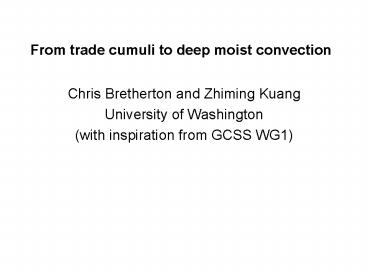From trade cumuli to deep moist convection - PowerPoint PPT Presentation
1 / 15
Title:
From trade cumuli to deep moist convection
Description:
Convective overshoot and penetrative entrainment are important in the long-term ... Adiabatic. A plume-ensemble view of entrainment. In-cloud PDF, hours 50-52 ... – PowerPoint PPT presentation
Number of Views:45
Avg rating:3.0/5.0
Title: From trade cumuli to deep moist convection
1
From trade cumuli to deep moist convection
- Chris Bretherton and Zhiming Kuang
- University of Washington
- (with inspiration from GCSS WG1)
2
Some features of trade cumulus convection
- Shallow Cu are always highly entraining.
- Convective overshoot and penetrative entrainment
are important in the long-term evolution of the
Cu layer. - Their typical buoyancy excess is much less than
undilute. - Their cloud base properties are connected to the
statistics of the subcloud layer turbulence the
Cu are the vertical extensions of the moistest,
strongest subcloud updrafts.
These points apply to most deep convection, but
are often overlooked in parameterizations.
3
BOMEX LES (Siebesma and Cuijpers 1995)
(dq/dt)adv - 1 g/kg-d Wmin -0.65 cm/s Qr -2
K/d
4
BOMEX GCSS results (Siebesma et al. 2003)
Overshooting Cu
Core lateral entrainment rate 1-2 km-1
Bottom-heavy cloud population
5
Clouds are barely buoyant
2-3s cloud base humidity, w excess
6
Feedbacks in shallow (and deep?) oceanic Cu
Cloudbase CIN is the rapid mass flux valve
-
Weaker CIN
More mass flux
More compensating Cu-layer warming
Penetrative entrainment slowly adjusts Cu buoyancy
-
More Cu buoyancy
Stronger updraft
More penetrative entrainment
Stronger ql stratification
(Bretherton et al. 2004, MWR)
7
Oceanic shallow-to-deep CRM
Setup BOMEX with enhanced SHF, LHF
(inadvertently doubled Qrad) CSU
CRM, Lx Ly 12.8 km, Lz 28 km.
Dx Dy 100 m, Dz 50 m below 12 km.
8
Results
143 hr
48 hr
9
Cloud fields (qcgt0.1 g/kg)
48 hr
143 hr
10
In-cloud buoyancy is remarkably small
Hor avg Cloud Wgt1 m/s Adiabatic
11
A plume-ensemble view of entrainment
In-cloud PDF, hours 50-52
- All updrafts are diluted.
- e 0.5-1/km
- in vigorous updrafts.
- Most cloud is much more dilute
0.25/km
0.5/km
Mass-flux PDF, hours 50-52
1/km
2/km 4/km
8
1
Wlt0
2
4
12
Later and deeper
Cloud PDF,158-160 hrs
- Qualitatively similar, but
- core updraft e 0.5/km.
0.25/km
0.5
1
2
e 4
Mass-flux PDF,158-160 hrs
8
4
2
1
Wlt0
13
Buoyancy and Vertical Velocity
qv, 50-52 hrs
cloud
- Even a little less dilution makes a very
strong updraft!
clear
w, 50-52 hrs
14
Conclusions
- Both for shallow and deep convection, all cumuli
are substantially entrainment-diluted such that
their mean buoyancy is nearly zero, even in
vigorous updrafts. - Below the LFC, the Cu mass flux is dominated by
updrafts with a narrow range of entrainment
rates, suggesting a single ensemble plume may
suffice. - Penetrative entrainment dominated by stronger,
less dilute updrafts- requires consideration of
plume ensemble. - Cloud base updraft properties represent moist
tail of PBL air mass flux is regulated via CIN. - Over the long term, penetrative entrainment
regulates mean sounding to keep typical cloud
buoyancy small.
15
qv, 158-160 hrs
w, 158-160 hrs































